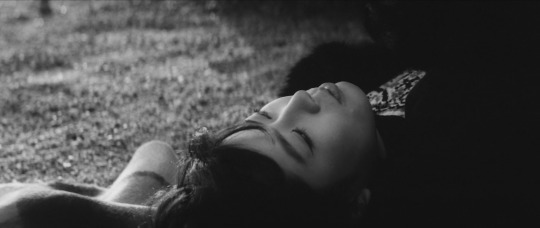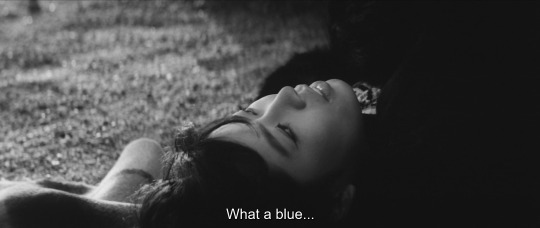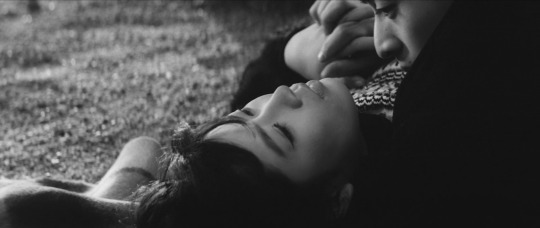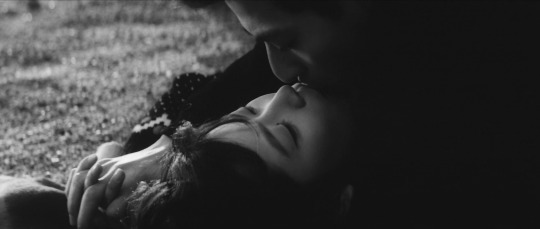#yoshi sugihara
Explore tagged Tumblr posts
Text

Twenty-Four Eyes (Keisuke Kinoshita, 1954)
Cast: Hideko Takamine, Chishu Ryu, Takahiro Tamura, Yumeji Tsukioka, Toshiko Kobayashi, Toshio Takahara, Shizue Natsukawa, Kumeko Urabe. Screenplay: Keisuke Kinoshita, based on a novel by Sakae Tsuboi. Cinematography: Hiroshi Kusuda. Art direction: Kimihiko Nakamura. Film editing: Yoshi Sugihara. Music: Chuji Kinoshita.
One of the most unabashedly sentimental movies you'll ever see, Twenty-Four Eyes may also be one of the most effective anti-war movies, without presenting bloody scenes of people being killed and maimed. Hideko Takamine plays Oishi, a young teacher who begins her career in 1928 on Shodo Island in the Inland Sea of Japan, teaching a first-grade class of 12 -- six boys and six girls -- the 24 eyes of the film's title. We follow her life, and through her point of view the lives (and some deaths) of her first pupils, for the next 18 years, as the world and the war encroach upon a peaceful, pastoral setting. Where Kinoshita's Morning for the Osone Family (1946) was claustrophobic in its presentation of life during wartime, Twenty-Four Eyes shows how the entrapment of people by war can occur in a place where there are no visible signs of the conflict. The natural setting remains undisturbed. No planes fly overhead, no bombs are dropped on the village, but the menace of war threatens the minds and hearts of the most vulnerable: the children Oishi teaches. The most chilling scenes are the ones in which young men are sent off to the war, as flag-waving crowds sing bloodthirsty tributes to the glory of dying in battle for their country. Kinoshita and cinematographer Hiroshi Kusuda reinforce the bitter irony by their restraint. They don't darken the atmosphere: It's the same lovely natural setting. Only the human beings in it have changed. I have to admit to feeling the movie is overlong, and that Kinoshita ladles on the pathos a bit too heavily. The cast weeps floods of tears, and the soundtrack features not only the Japanese folk songs that the children learn but also some old-fashioned Western parlor songs: "Annie Laurie," "The Last Rose of Summer," "Home, Sweet Home," "Auld Lang Syne," and, most curiously, "What a Friend We Have in Jesus." But repress the cynic or the realist, and you may find it moving, too.
3 notes
·
View notes
Photo










Blood Is Dry (Yoshishige Yoshida, 1960).
#chi wa kawaiteru#chi wa kawaiteru (1960)#blood is dry (1960)#blood is dry#yoshishige yoshida#tôichirô narushima#yoshi sugihara#kiminobu satô#yoshie taguchi
59 notes
·
View notes
Photo



Sleep tight, tiny lizard.
I really really need to level Noriko... Smol, sweet.
#noriko sugihara#noriko#ffxiv#ffxiv rp#aisbraena#raen#au ra#female#mosnter girl#I wish#damn you yoshi
4 notes
·
View notes
Link
9 notes
·
View notes
Photo

[Announcement] 舞台 逆転検事 ~ 逆転のテレポーテーション (butai gyakuten kenji ~ gyakuten no teleportation)
the saien will start next month^^ (November 2nd, 2017 - November 7th, 2017)
homepage shoen twitter
Cast:
Wada Takuma as Mitsurugi Reiji Arai Reira as Ichijou Mikumo Isogai Ryuuko as Itonokogiri Keisuke Hayashi Akihiro as Yahari Masahi Miyashita Yuuya as Chijou Yaichirou Kuge Megumi as Ooba Kaoru Shinagawa Shou as Takanashi Mamoru Tonoshiro Yuuma as Nakatori Motsuma Noguchi Mao as Houzuki Akane Kanade as Kurono Koyuki Shimomura Aya as Ukon Yoshie Ikeda Kenshin as Za Kanji??? Yonemaru Hinata as Shouji Shougo??? Koyama Shun as Baba Tomo??? Inoue Kaho as Ozaki Masshi??? Sugihara Isamu as Tenma Tsubaki Tomita Shou as Asukai Tomorou
#逆転検事#gyakuten kenji#和田琢磨#wada takuma#荒井レイラ#arai reira#磯貝龍虎#isogai ryuuko#林明寛#hayashi akihiro#宮下雄也#miyashita yuuya#久下恵美#kuge megumi#品川翔#shinagawa shou#登野城佑真#tonoshiro yuuma#野口真緒#noguchi mao#下村彩#shimomura aya#池田謙信#ikeda kenshin#米丸日向#yonemaru hinata#小山峻#koyama shun#井上果歩#inoue kaho
12 notes
·
View notes
Photo


WELCOME 2 BASS BASE vol.4 at Born Free Kobe 2018.04.07.sat. open...16:30 / close...23:00 charge....1000yen genre...Hip Hop, R&B, Soul, Funk, Jazz & Good Music -GUEST DJ- YOSHI a.k.a.VINYL CAT NODDY -GUEST LIVE- RAYJER of 嗚呼 -DJ- SUGIHARA THE 3RD NIFELINE ATTACK SHINGO FUCKMURA FLUSH -LIVE- THE BLANK DRAGY -FOOD- パオライス -At- Born Free Kobe 兵庫県神戸市東灘区岡本2-5-8 B1 TEL: 078-441-7890 ●JR摂津本山駅から徒歩5分 ●阪急岡本駅から徒歩7分
0 notes
Text

The Face of Another (Hiroshi Teshigahara, 1966)
Cast: Tatsuya Nakadai, Machiko Kyo, Mikijiro Hira, Kyoko Kishida, Miki Irie, Eiji Okada, Minoru Chiaki, Hideo Kanzi, Kunie Tanaka. Screenplay: Kobo Abe, based on his novel. Cinematography: Hiroshi Segawa. Production design: Masao Yamazaki. Film editing: Yoshi Sugihara. Music: Toro Takemitsu.
Kobo Abe based the screenplay for The Face of Another on his own novel, and I suspect that adherence to the source weakens the film, which dwells heavily on ideas about identity and morality that are more efficiently explored in literature than in cinema. The central narrative deals with Okuyama (Tatsuya Nakadai) who, having been disfigured in an industrial accident, sees a psychiatrist (Mikijiro Hira) who devises an experimental mask that gives Okuyama an entirely new identity. Wearing the mask, Okuyama seduces his own wife (Machiko Kyo), who tells him that she knew who he was all along and assumed that he was trying to revive their marriage, which had been troubled since his accident. She is enraged when she learns that he was in fact testing her fidelity. But there is a secondary narrative about a beautiful young woman (Miki Irie) who bears scars along one side of her face that, it is suggested, are the result of exposure to radiation from the Nagasaki atomic bomb. In the novel, this story comes from a film that was seen by Okuyama, but Hiroshi Teshigahara withholds this explanation for including it without apparent connection to Okuyama's story. I'm not troubled by the disjunction this creates in the film, because Teshigahara and production designer Masao Yamazaki have developed a coherent symbolic style that creates an appropriate air of mystery throughout The Face of Another. The weakness lies, I think, in the dialogue, especially in the too didactic exchanges between Okuyama and the psychiatrist about the limits and potential of a mutating identity. Nevertheless, it's a fascinating, flawed film, more disturbing than most outright "horror" movies.
2 notes
·
View notes
Text

Haruko Sugimura, Mitsuko Miura, and Eitaro Ozawa in Morning for the Osone Family (Keisuke Kinoshita, 1946)
Cast: Haruko Sugimura, Toshinosuke Nagao, Shin Tokudaiji, Mitsuko Miura, Shiro Osaka, Eitaro Ozawa, Natsuko Kahara, Junji Masuda, Kinji Fujiwa, Eijiro Tono. Screenplay: Eijiro Hisaita. Cinematography: Hiroshi Kusuda. Art direction: Mikio Mori. Film editing: Yoshi Sugihara. Music: Takaaki Asai.
One of the myths of war is that the enemy moves in lockstep, from the commander-in-chief down to the lowliest citizen. So the image of World War II Japan as a monolithic force lingers, even though years of peace with the Japanese and a wholesale assimilation by the West of their culture, from sushi to anime, have effaced old hostilities. Keisuke Kinoshita's first postwar film, Morning for the Osone Family, gives us a valuable sense of the way things were -- or at least may have been -- for a Japanese family during wartime. Working in the year after the surrender of Japan, after ideological censorship had ceased (though the American occupation imposed its own censorship, which is why you'll find no mention of the atomic bomb in Japanese movies made just after the war), Kinoshita and screenwriter Eijiro Hisaita tell the story of a widow, Fusako (Haruko Sugimura), and her three sons, her daughter, and her brother-in-law in the waning years of the war. One son is imprisoned for writing against the war; the daughter is forced to break off her engagement to a young man because of the political implications of what her brother did; another son, a pacifist who wants to be an artist, is drafted and dies of pneumonia in a hospital; the youngest son, embracing the militarist propaganda, enlists and is killed. And then there is the domineering presence of the brother-in-law (Eitaro Ozawa), a colonel who despises the way Fusako has raised her children to doubt the glory of the Japanese military. When his house is destroyed by bombing, he moves in with the Osone family and takes over the household. Devastated by the surrender, he begins to stockpile food in their house, even as starvation spreads across the land. The film takes place on a single set, which only emphasizes the sense of a world closing in on the family. We might question how representative the Osone family is of the Japanese citizenry, but we could also question the accuracy of the "home front" movies made in the United States during and after the war.
1 note
·
View note
Photo










Bitter End of a Sweet Night (Yoshishige Yoshida, 1961).
#bitter end of a sweet night (1961)#bitter end of a sweet night#amai yoru no hate#yoshishige yoshida#yôichi maeda#masahiko tsugawa#tôichirô narushima#yoshi sugihara#tadataka yoshino#shigeo fukasawa#kôshichi yoshida
55 notes
·
View notes
Photo










Bitter End of a Sweet Night (Yoshishige Yoshida, 1961).
#amai yoru no hate#bitter end of a sweet night#yoshishige yoshida#masahiko tsugawa#tôichirô narushima#yoshi sugihara#tadataka yoshino#shigeo fukasawa#kôshichi yoshida
49 notes
·
View notes
Photo










Blood Is Dry (Yoshishige Yoshida, 1960).
#yoshie taguchi#yoshishige yoshida#blood is dry#blood is dry (1960)#chi wa kawaiteru#chi wa kawaiteru (1960)#tôichirô narushima#yoshi sugihara#kiminobu satô#keiji sada
23 notes
·
View notes
Photo










Hokusai manga (Kaneto Shindô, 1981).
#kaneto shindô#hokusai manga (1981)#hokusai manga#seiichi yashiro#ken ogata#toshiyuki nishida#keiji maruyama#yoshi sugihara#shigemori shigeta
75 notes
·
View notes
Photo










Kawaita hana (Masahiro Shinoda, 1964).
#kawaita hana (1964)#masahiro shinoda#shintarô ishihara#masaru baba#masao kosugi#yoshi sugihara#shigemasa toda#kawaita hana#pale flower (1964)#pale flower#sesión de madrugada#sesiondemadrugada
223 notes
·
View notes
Photo










Kawaita hana (Masahiro Shinoda, 1964).
#Kawaita hana (1964)#pale flower (1964)#masahiro shinoda#masao kosugi#yoshi sugihara#shigemasa toda#Hatsuo Kojima#ryô ikebe#kawaita hana#pale flower#sesión de madrugada#sesiondemadrugada
66 notes
·
View notes
Photo

Tatsuya Nakadai in The Scandalous Adventures of Buraikan (Masahiro Shinoda, 1970) Cast: Tatsuya Nakadai, Shima Iwashita, Tetsuro Tanba, Shoichi Ozawa, Fumio Watanabe, Suisen Ichikawa, Masakane Yonekura, Jun Hamamura. Screenplay: Shuji Terayama, based on a play by Mokuami Kawatake. Cinematography: Kozo Okazaki. Art direction: Shigemasa Toda. Film editing: Yoshi Sugihara. Music: Masaru Sato. I think I was culturally ill-equipped for The Scandalous Adventures of Buraikan, a wittily stylized film that presupposes an acquaintance with Japanese history and culture that I don't possess. From my own culture, I bring a knowledge of 18th-century portrayals of London lowlife, such as the pictures of Hogarth and the satire in John Gay's The Beggar's Opera. Buraikan has echoes for me of those, as well as, in its portrayal of the puritanical reformer's zeal, Shakespeare's Measure for Measure. But for much of the film I felt at sea. That said, I like Tatsuya Nakadai so much I'd watch him read the Tokyo telephone book.
2 notes
·
View notes
Photo

Hideko Takamine in Danger Stalks Near (Keisuke Kinoshita, 1957) Cast: Hideko Takamine, Keiji Sada, Akiko Tamura, Koji Nanbara, Toshiko Kobayashi, Hiroko Ito, Masako Arisawa, Ryo Ono, Kotohisa Saotome, Yoshihide Sato, Koji Satomi, Saburo Sato, Akira Oze, Shoji Sayama, Shinji Tanaka. Screenplay: Keisuke Kinoshita. Cinematography: Hiroshi Kusuda. Art direction: Chiyoo Umeda. Film editing: Yoshi Sugihara. Music: Chuji Kinoshita. Nothing about the English title suggests that you're going to get the comedy of errors that Danger Stalks Near turns out to be, or that its star, Hideko Takamine, usually seen in serious, often glamorous roles, will play a mousy, bespectacled housewife under the domination of her tyrannical mother-in-law. The film starts out with two young thugs bullying Kohei (Shinji Tanaka), a man from the country who needs money to return home, into robbing a suburban house. But as they case the joint from a nearby hillside, things constantly happen to keep them from their goal. The house is the property of Tetsu Sato (Akiko Tamura), a war widow, who lets her son, Kaneshige (Keiji Sada), and his wife, Yuriko (Takamine), and their son, Kazuo (Kotohisa Saotome), live there. She also rents a room to Miyoko ( Hiroko Ito), a flighty young woman who starts the day's madness off by burning a hole in the tatami mat in her room. Tetsu immediately evicts her. Things snowball from there, with the tatami repairman coming and going, movers arriving, Yuriko's sisters showing up with various problems of their own, Yuriko returning with her boyfriend to demand the remaining day she had paid for in rent, an old friend of Kaneshige's arriving and revealing his own larcenous aims, and various other unexpected incidents. The three would-be thieves watch in dismay as their opportunity to bust in and steal what they -- and others -- believe to be a considerable amount of money belonging to Tetsu disappears. Kinoshita piles on the complications, and in the process unveils some of the hidden motives and simmering resentments of the members of the household. For once, Kinoshita lets his cynical side dominate, diluting some of the syrup that often makes his films a little sticky.
2 notes
·
View notes